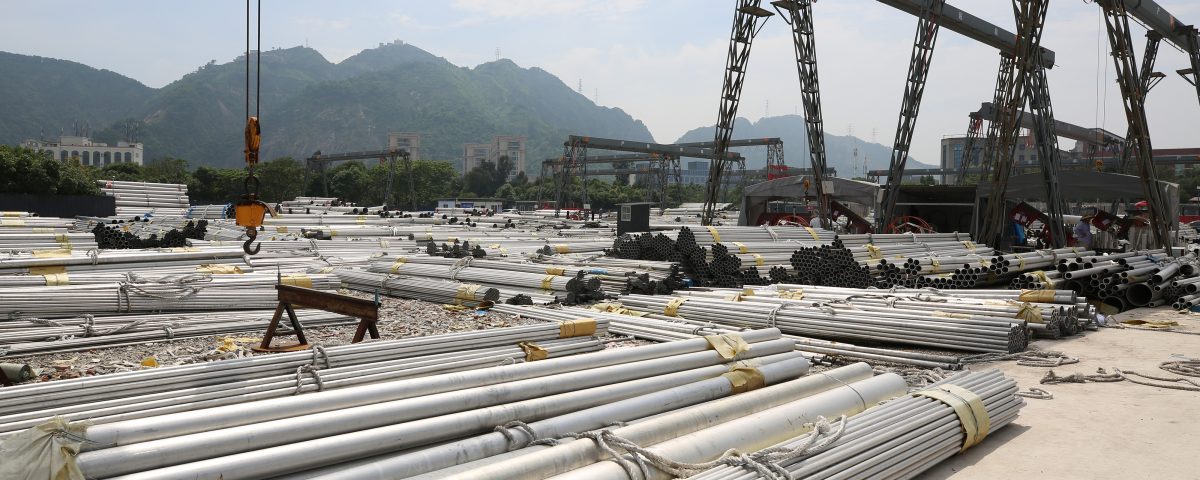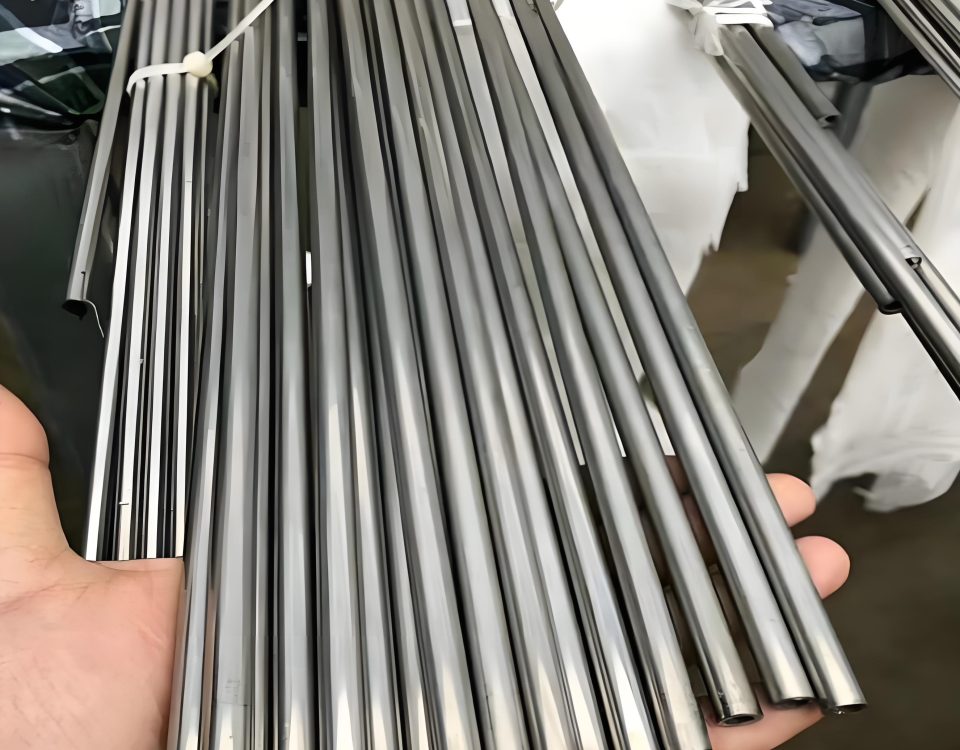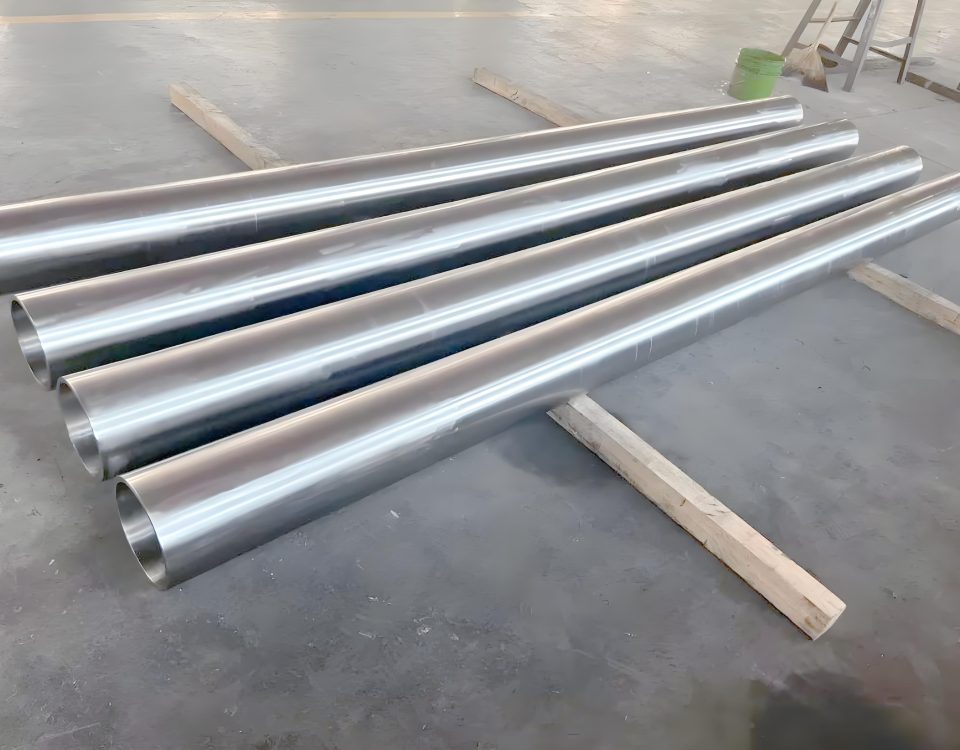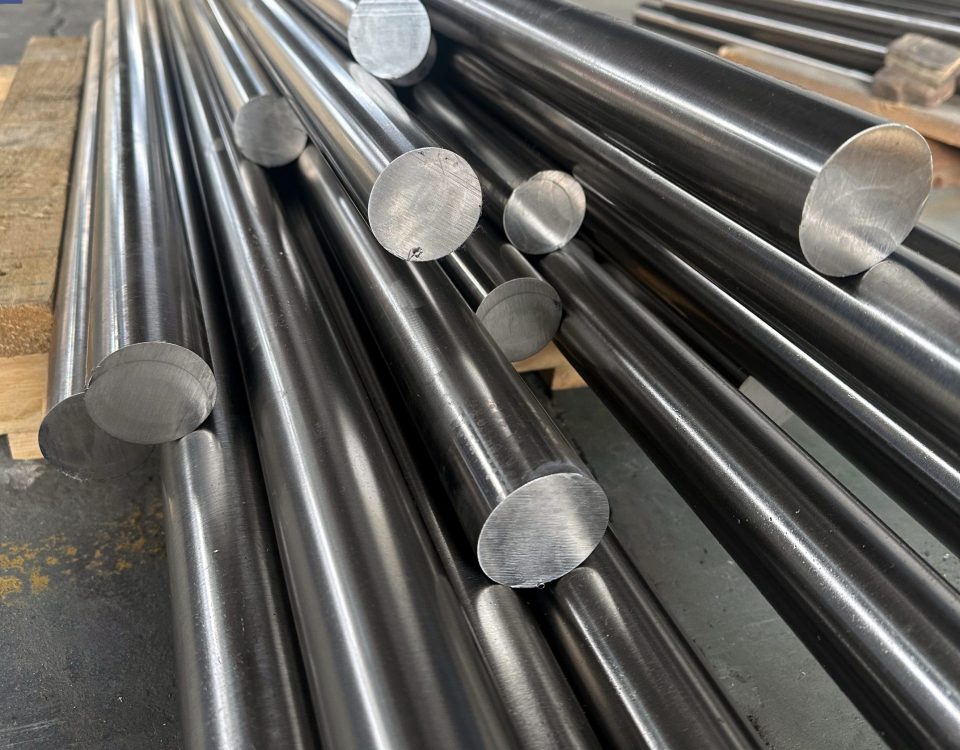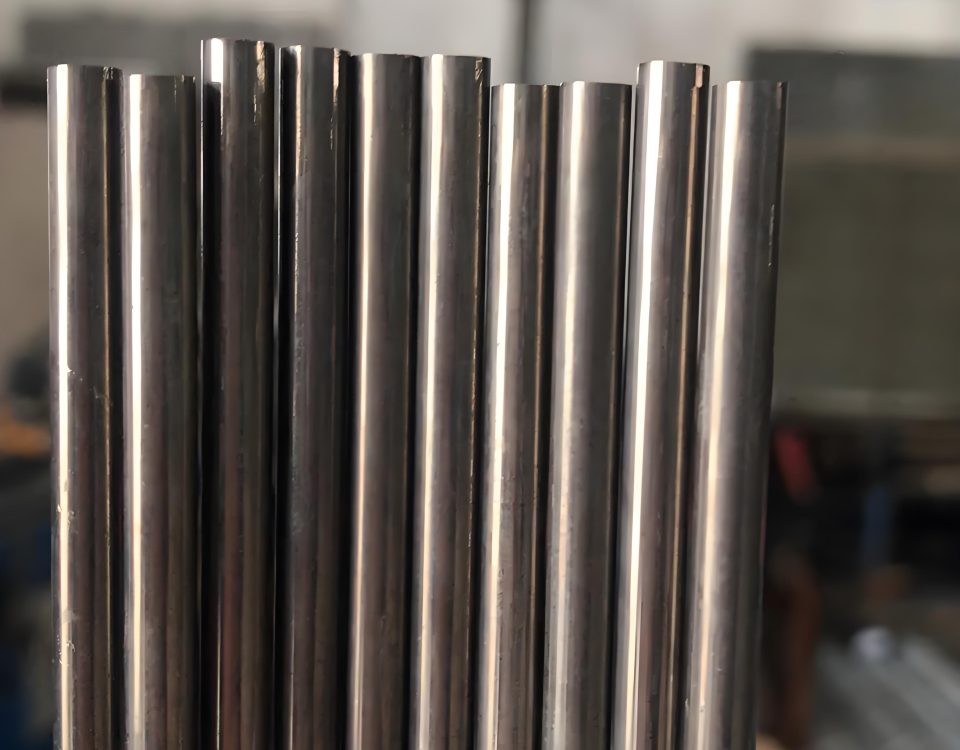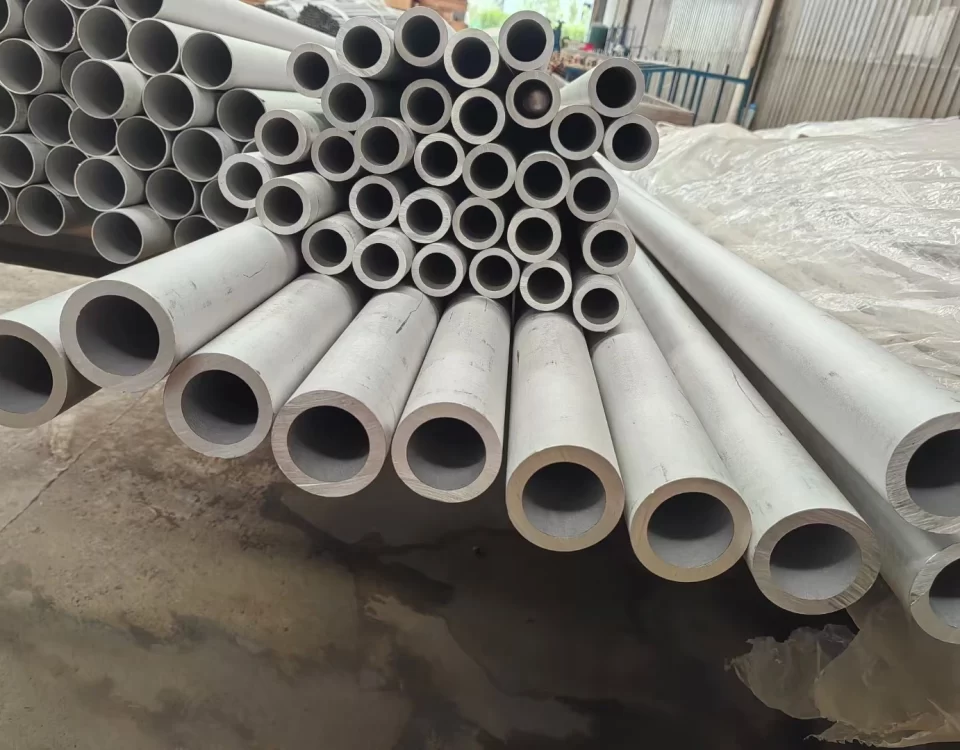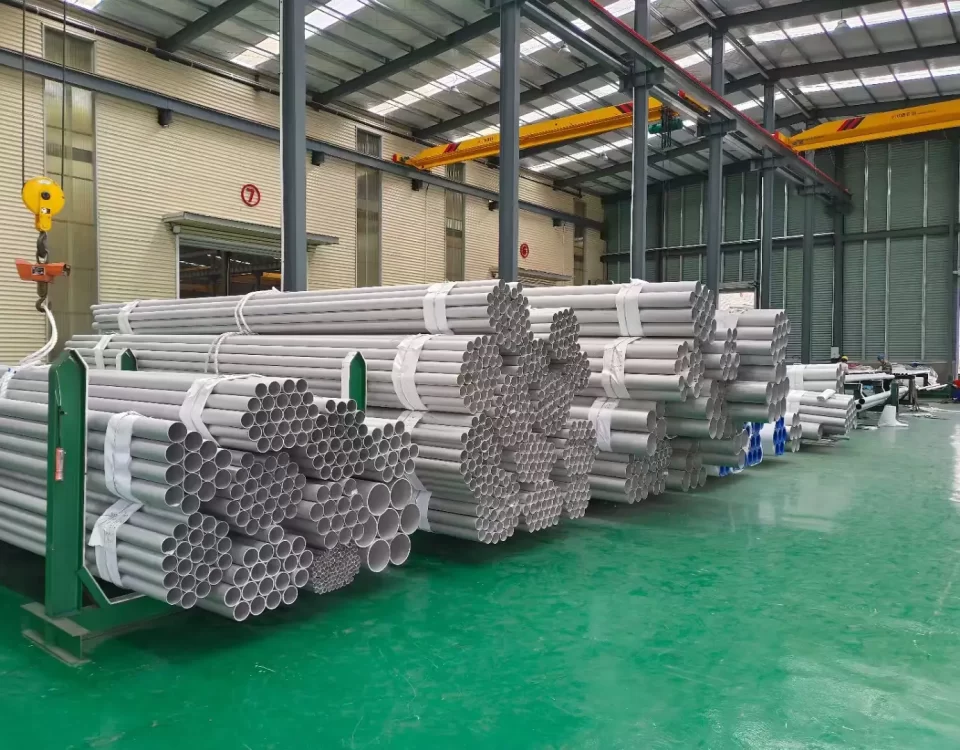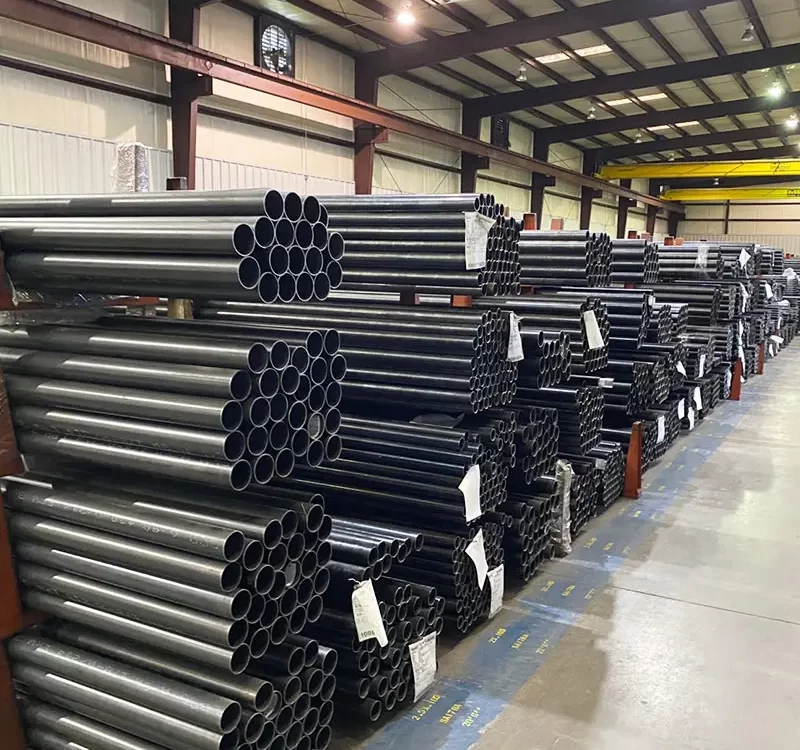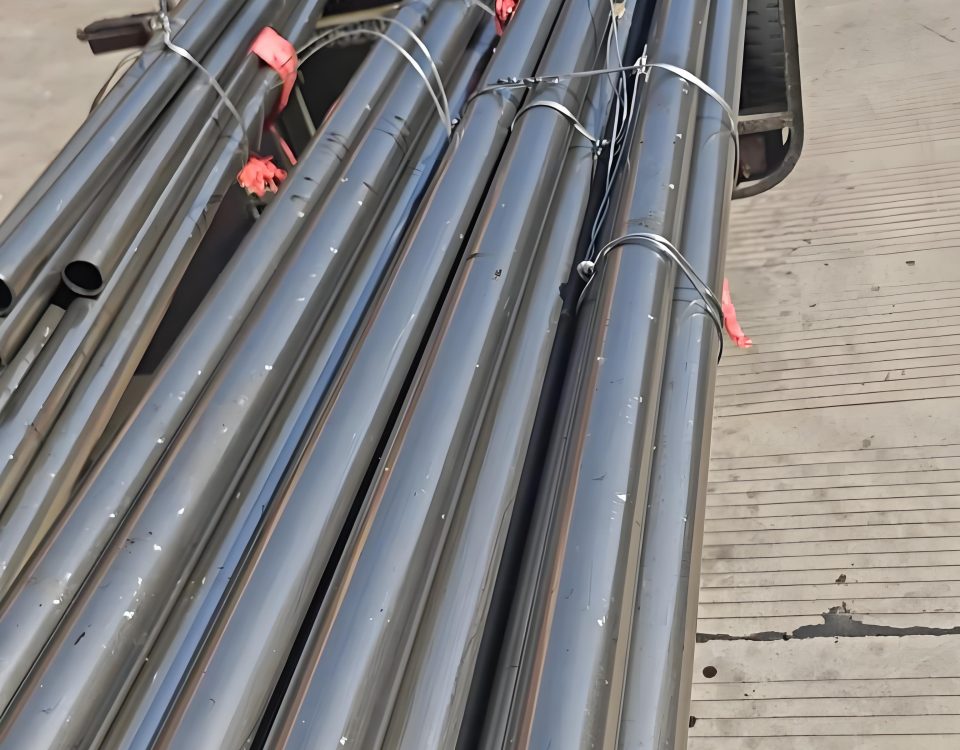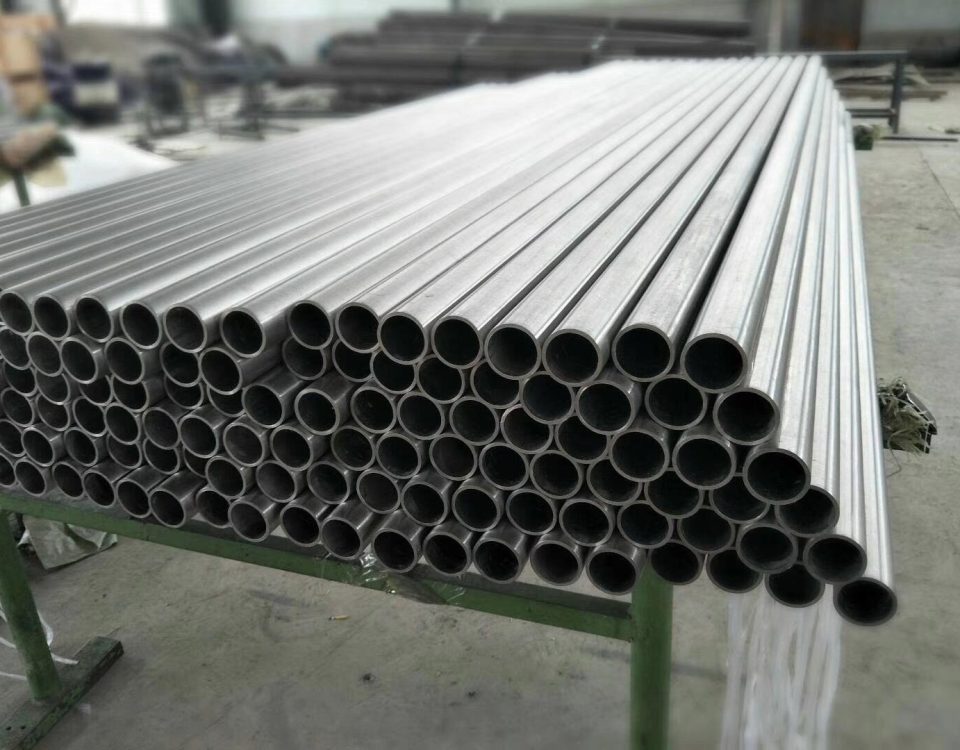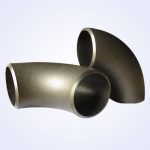
Ellbogen der Kohlenstoffstahl -Pipeline basierend auf dem Fernfeld -Wirbelstrom basieren
September 20, 2025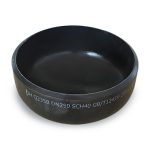
Rohrkappen aus Kohlenstoffstahl
September 26, 2025Der industrielle Eckpfeiler von reinem Nickel: Nickel 200 (UNS N02200) Legierungsrohre – Ein umfassender Überblick
Kapitel I: Einführung - Definition, Historischer Status, und Kernwert von kommerziell reinem Nickel
1.1 Die Bedeutung von kommerziell reinem Nickel und die Entstehung von Nickel 200
In der heutigen hochspezialisierten und anspruchsvollen Industrieproduktionsumgebungen, Die Anforderungen an die Materialleistung gehen weit über die grundlegende mechanische Festigkeit hinaus. Bei Kontakt mit aggressiven Chemikalien Korrosion, spezielle elektrische/thermische Anforderungen, und strenge Produktreinheitsstandards, Gewöhnliche metallische Materialien erweisen sich oft als unzureichend. In diesem Zusammenhang ist das der Fall Nickelbasislegierungen, insbesondere Nickel 200 (UNS N02200), bekannt als “Kommerziell reines Nickel,” haben sich als unverzichtbare Grundlage für zahlreiche kritische Industrieprozesse etabliert, dank ihrer einzigartigen Kombination aus hoher chemischer Reinheit und herausragenden Eigenschaften.
Nickel 200 ist keine neue Innovation; Seine Geschichte reicht bis in die 1930er Jahre zurück, ursprünglich von der ehemaligen International Nickel Company entwickelt (Inco). Es handelt sich um eine der reinsten kommerziell erhältlichen Nickellegierungen, typischerweise ist ein Nickelgehalt von erforderlich nicht weniger als \(99.0\%\). Diese außergewöhnliche Reinheit verleiht ihm einzigartige physikalische und chemische Eigenschaften, insbesondere seine unübertroffene Stabilität und Korrosionsbeständigkeit bei aggressiven Einflüssen ätzende alkalische Medien– eine Position, die das Unternehmen im kritischen Sektor der chemischen Verarbeitung unnachgiebig einnimmt.
Unser Unternehmen ist spezialisiert auf die R&D und Herstellung von Nickel 200 / UNS N02200 Nickellegierung Tubes. Als entscheidende Komponente für den Flüssigkeitstransfer, Wärmeaustausch, und Strukturförderung, Die Qualität unserer Schläuche bestimmt direkt die Zuverlässigkeit und Lebensdauer des gesamten Systems. Wir erkennen an, dass die Herstellung eines konformen Nickels erfolgt 200 Bei Rohren handelt es sich nicht nur um einen Metallumformprozess; Es handelt sich um ein systemisches Unterfangen, das die Metallurgie einbezieht, Präzisionsbearbeitung, zerstörungsfreie Prüfung (NDT), und strenge Qualitätskontrolle. Wir bieten mehr als nur Metallrohre; Wir bieten ein langfristiges Engagement für die industrielle Kontinuität, Produktreinheit, und Sicherheit, basiert auf einem tiefen Verständnis der Materialwissenschaft und einem kompromisslosen Streben nach Fertigungsexzellenz.
1.2 Wichtige technische Besonderheit: Nickel 200 vs. Nickel 201 und die Temperaturgrenze
Bevor wir uns mit den Leistungsmerkmalen von Nickel befassen 200, Es ist von entscheidender Bedeutung, den erheblichen Unterschied zwischen ihm und seinem kohlenstoffärmeren Gegenstück zu verdeutlichen, Nickel 201 (UNS N02201). Diese Unterscheidung stellt ein wichtiges technisches Kriterium für die Legierungsauswahl dar:
- Nickel 200 (UNS N02200): Der Kohlenstoffgehalt wird bis zu einem Maximum von kontrolliert \(0.15\%\).
- Nickel 201 (UNS N02201): Der Kohlenstoffgehalt wird streng kontrolliert unter \(0.02\%\).
Dieser scheinbar geringfügige Unterschied im Kohlenstoffgehalt führt zu einer großen Divergenz in der Anwendungsleistung: Nickel 200 ist anfällig für Graphitisierung oder Sensibilisierung (intergranulare Karbidausfällung) wenn es höheren Temperaturen ausgesetzt wird \(315^ circ text{C}\) (\(600^ circ text{F}\)) über längere Zeiträume, was die Empfindlichkeit gegenüber interkristalliner Korrosion erhöht. Deshalb, **Nickel 200 wird hauptsächlich von Metallurgieingenieuren für die unten aufgeführten Serviceumgebungen empfohlen \(315^ circ text{C}\)**.
Nickel 201 wurde speziell entwickelt, um dieses Problem der Hochtemperatursensibilisierung zu überwinden, und ist **für die oben genannten Umgebungen geeignet \(315^ circ text{C}\)**, Sicherstellen, dass das Material seine korrosive Integrität bei erhöhten Betriebstemperaturen beibehält. Als professioneller Rohrhersteller, Wir kontrollieren die chemische Zusammensetzung der Rohstoffe sorgfältig und können Nickel flexibel liefern 200 oder Nickel 201 basierend auf den spezifischen Betriebstemperatur- und Anwendungsanforderungen des Kunden, Gewährleistung einer wissenschaftlichen und angemessenen Materialauswahl.
Kapitel II: Tauchen Sie tief in die Welt des Nickels ein 200 Legierungsmaterialwissenschaft: Die Logik von Reinheit und Leistung
2.1 Chemische Zusammensetzung: Reinheit als Grundlage der Leistung
Der Kernwert von Nickel 200 liegt in seiner chemischen Reinheit. Die hochreine Nickelmatrix garantiert nicht nur eine hervorragende Korrosionsbeständigkeit, sondern liefert auch einzigartige funktionelle physikalische Eigenschaften, wie hohe elektrische Leitfähigkeit und Ferromagnetismus. Tabelle 1 Einzelheiten zu den primären Anforderungen an die chemische Zusammensetzung, die in der Norm UNS N02200 festgelegt sind (unter Bezugnahme auf ASTM B163/B161), Dies ist der verbindliche Maßstab für unsere Rohrproduktion:
| Element | UNS N02200-Standard (ASTM B163/B161) Maximaler Inhalt (%) | Bedeutung und Wirkung |
|---|---|---|
| Nickel (NI) + Kobalt (Co) | Min. \(99.00\) | Gewährleistet primäre Korrosionsbeständigkeit, hohe Duktilität, Leitfähigkeit, und magnetostriktive Eigenschaften. |
| Kohlenstoff (C) | Max. \(0.15\) | Beeinflusst die Empfindlichkeit gegenüber interkristalliner Korrosion (Sensibilisierung) bei hohen Temperaturen. Der hohe C-Gehalt ist das Hauptunterscheidungsmerkmal zu Ni 201. |
| Kupfer (Cu) | Max. \(0.25\) | Streng kontrolliert, um eine Beeinträchtigung der Stabilität von reinem Nickel in ätzenden Alkalilösungen zu vermeiden. |
| Eisen (Fe) | Max. \(0.40\) | Verunreinigungselement, beeinflusst die Reinheit, elektrische Leitfähigkeit, und magnetische Eigenschaften. Hoch \(\Text{Fe}\) Der Inhalt verringert die Leitfähigkeit. |
| Mangan (MN) | Max. \(0.35\) | Gängiges Desoxidationsmittel, kontrolliert, um die Reinheit aufrechtzuerhalten und die Schweißbarkeit zu beeinträchtigen. |
| Silizium (Si) | Max. \(0.35\) | Gängiges Desoxidationsmittel, Ein übermäßiger Gehalt verringert die Duktilität. |
| Schwefel (S) | **Max. \(0.01\)** | **Muss extrem niedrig sein.** Sulfide beeinträchtigen die Hochtemperaturzähigkeit erheblich, Schweißbarkeit, und Korrosionsbeständigkeit, kann leicht zu Kurzatmigkeit führen. |
| Andere | Max. \(0.10\) | Kontrolle der gesamten Restverunreinigungen, um insgesamt eine hohe Reinheit sicherzustellen. |
Tabelle 1: Anforderungen an die chemische Zusammensetzung von Nickel 200 (UNS N02200) Legierungsrohre
2.2 Physikalische Eigenschaften: Die Basis für funktionale Anwendungen
Die physikalischen Eigenschaften einer hochreinen Nickellegierung machen sie in vielen Branchen einzigartig, insbesondere in der elektrischen Übertragung und Thermodynamik. Nickel 200 ist ferromagnetisch (unterhalb seiner Curie-Temperatur von ca \(360^ circ text{C}\)) und besitzt eine hohe thermische und elektrische Leitfähigkeit, Ein Vorteil, der vielen anderen Superlegierungen auf Nickelbasis fehlt.
| Physisches Eigentum | Typischer Wert | Einheit | Notizen |
|---|---|---|---|
| Dichte | \(8.89\) | \(\Text{g/cm}^3\) | Relativ schwer, Dies spiegelt die hohe Packungsdichte der Nickelatome wider. |
| Schmelzbereich | \(1435 – 1446\) | \(\Text{^ circ text{C}}\) | Hoher Schmelzpunkt, Bietet eine gute thermische Stabilität für Hochtemperaturanwendungen. |
| Curie-Temperatur | \(360\) | \(\Text{^ circ text{C}}\) | Zeigt unterhalb dieser Temperatur Ferromagnetismus. |
| Wärmeausdehnungskoeffizient | \(13.3 \mal 10^{-6}\) | \(\Text{K}^{-1}\) | Durchschnittswert zwischen \(20^ circ text{C}\) und \(100^ circ text{C}\). |
| Wärmeleitfähigkeit | \(70.2\) | \(\Text{W/(m}\cdot\text{K)}\) | Wert bei \(21^ circ text{C}\). Besser als Edelstahl und viele Ni-Cr-Legierungen, vorteilhaft für den Wärmeaustausch. |
| Elektrische Leitfähigkeit | \(\ca. 15 – 20\) | \(\%\) IACS | Deutlich höher als die meisten Nickellegierungen, nähert sich der Leitfähigkeit von Kupfer, Ideal für elektronische Anwendungen. |
| Elastizitätsmodul | \(205\) | \(\Text{GPa}\) | Spiegelt die Steifigkeit des Materials wider, vergleichbar mit Stahl. |
Tabelle 2: Typische physikalische Eigenschaften von Nickel 200 Legierungsrohre
2.3 Mechanische Eigenschaften: Individualisierung durch Kaltumformung und Glühen
Als handelsübliches reines Nickel, Nickel 200 Eigenschaften ausgezeichnet Duktilität und gute Kaltverformbarkeit, Dies erleichtert das präzise Kaltziehen und Walzen – eine entscheidende Voraussetzung für die Herstellung dünnwandiger Produkte, Hochpräzise Rohre. Die endgültigen mechanischen Eigenschaften des Rohrs hängen weitgehend von seiner abschließenden Wärmebehandlung ab (z.B., geglühter oder kaltgezogener Zustand).
Tabelle 3 listet die allgemeinen mechanischen Eigenschaftsziele für **geglühtes** Nickel auf 200 Röhren, Parameter, die durch Zugversuche innerhalb unseres Qualitätskontrollsystems überprüft werden müssen:
| Mechanische Eigenschaften | Typischer Wert im geglühten Zustand | Einheit | ASTM B163 Mindestanforderung (Minute) |
|---|---|---|---|
| Zerreißfestigkeit | \(400 – 550\) | \(\Text{MPa}\) | \(380\) |
| Streckgrenze (0.2% ausgleichen) | \(105 – 200\) | \(\Text{MPa}\) | \(105\) |
| Dehnung | \(45 – 60\) | \(\%\) | \(35\) |
| Rockwell-Härte | \(60 – 75\) | \(\Text{HRB}\) | – |
Tabelle 3: Mechanische Eigenschaftsziele für Nickel 200 Legierungsrohre (Geglühter Zustand)
Durch präzise Steuerung des Kaltumformungsreduktionsverhältnisses und des anschließenden Glühprozesses, Wir können das Endergebnis der Röhre individuell anpassen Temperament. Zum Beispiel, die kaltgezogen Zustand kann seine Streckgrenze deutlich erhöhen (bis zu \(450 \Text{MPa}\) oder mehr) auf Kosten einer gewissen Duktilität, Dadurch eignet es sich für Anwendungen, die eine höhere strukturelle Festigkeit erfordern. Diese präzise Fähigkeit, die endgültigen mechanischen Eigenschaften abzustimmen, unterstreicht unsere umfassende Expertise in der Rohrherstellung.
Kapitel III: Tauchen Sie tief in die überlegene Korrosionsbeständigkeit von Nickel ein 200
3.1 Das “Korrosionskönig” in ätzenden alkalischen Medien: Kernkompetenz
Nickel 200 verdient seinen Ruf als “Korrosionskönig” vor allem aufgrund seiner unübertroffenen Korrosionsbeständigkeit Ätzalkalien wie Natriumhydroxid (\(\Text{NaOH}\)) und Kaliumhydroxid (\(\Text{KOH}\)). Diese aggressiven Chemikalien, auch bei hohen Konzentrationen und Temperaturen, greift die meisten rostfreien Stähle und Nickel-Chrom-Eisen-Legierungen stark an.
Korrosionsbeständiger Mechanismus von Nickel 200: Die Oberfläche von Nickel bildet schnell eine dünne Schicht, dicht, und sehr stabil passiver Oxidfilm (\(\Text{NiO}\)). Dieser Oxidfilm ist chemisch inert und in starken alkalischen Lösungen äußerst stabil. Es isoliert das Metallsubstrat wirksam vom korrosiven Medium, überlegene Bereitstellung, Langzeit-Korrosionsschutz. Die Stabilität dieses passiven Films ist der entscheidende Faktor, der Nickel ermöglicht 200 um andere Legierungen zu übertreffen.
- Ätznatron (\(\Text{NaOH}\)) Anwendungen: Nickel 200 zeigt in nahezu allen Konzentrationen und Temperaturen eine hervorragende Leistung \(\Text{NaOH}\) Lösungen. In der Chlor-Alkali-Industrie, wo Wasser verdampft, um es zu konzentrieren \(\Text{NaOH}\), Nickel 200 Rohre sind das **Standardmaterial der Wahl** für Heiz- und Verdampferrohre, Garantiert eine lange Lebensdauer der Geräte und die Reinheit der \(\Text{NaOH}\) Produkt.
- **Erneute Hochtemperaturgrenzen:** Das \(315^ circ text{C}\) Die Temperaturbegrenzung ist von entscheidender Bedeutung. Für ätzende Hochtemperaturanwendungen oberhalb dieses Grenzwerts, Wir empfehlen dringend die Verwendung des extrem kohlenstoffarmen Produkts Nickel 201 um das Risiko einer Sensibilisierung zu mindern und die Sicherheit des Langzeitbetriebs zu gewährleisten.
3.2 Komplexes Verhalten in sauren Umgebungen und wässrigen Medien
Die Säurebeständigkeit von Nickel 200 ist selektiv und hängt stark von der Art der Säure und dem Oxidationszustand der Lösung ab:
- **Reduzierende Säuren:** In nicht oxidierenden und de-aeriert Lösungen von Salzsäure (\(\Text{HCl}\)) und Schwefelsäure (\(\Text{H}_2text{ALSO}_4\)), Nickel 200 besitzt eine gewisse Toleranz. Der kritische Zustand ist die Entlüftung. Das Vorhandensein auch nur Spuren von Sauerstoff oder Oxidationsmitteln (wie \(\Text{Fe}^{3+}\) Ionen) zerstört den in der reduzierenden Umgebung gebildeten Passivfilm, was zu einem starken Anstieg der Korrosionsrate führt.
- **Oxidierende Säuren:** Nickel 200 **ist für stark oxidierende Säuren wie Salpetersäure ungeeignet** (\(\Text{HNO}_3\)) oder konzentrierte Schwefelsäure. In diesen Medien, Die Korrosionsrate ist unerschwinglich hoch. Legierungen mit höherem Cr- oder Mo-Gehalt (wie \(\Text{Inconel}\) oder \(\Text{Hastelloy}\) Serie) sind hier typischerweise erforderlich.
- **Wässrige Medien und Salzwasser:** In neutralen und alkalischen Salzlösungen, sowie stehendes oder langsam fließendes Süßwasser, Korrosionsbeständigkeit ist gut. Jedoch, in Meerwasser mit hoher Geschwindigkeit oder in stehenden Gebieten mit Ablagerungen, das Risiko von Lochfraß und Spaltkorrosion erhöht sich. Für Anwendungen, die eine bessere Meerwasserbeständigkeit erfordern, Legierungen mit höherer Beständigkeit gegenüber Chloridionen, wie \(\Text{Ni-cu}\) Serienlegierungen (\(\Text{Monel 400}\)), werden oft gewählt.
3.3 Beständigkeit gegen trockene Halogengase und Hochtemperaturoxidation
- **Trockene Halogene:** Bei hohen Temperaturen, Nickel 200 zeigt eine gute Korrosionsbeständigkeit in trockenen Halogengasen wie Chlor (\(\Text{Cl}_2\)) und Fluor (\(\Text{F}_2\)). Jedoch, Dazu muss die Atmosphäre **absolut trocken** sein, da die Anwesenheit von Feuchtigkeit die Korrosionsreaktion erheblich beschleunigt.
- **Hochtemperaturoxidation:** Im Trockenen, oxidierende Luft, Die Oxidationsbeständigkeit von Nickel 200 ist gut, verwendbar bis ca \(1200^ circ text{C}\). Jedoch, wenn die Umwelt **Schwefelverbindungen** oder **reduzierende Gase** einbringt, Die Hochtemperaturleistung des Nickelbasismaterials wird stark beeinträchtigt. Nickel reagiert mit Schwefel unter Bildung von Nickelsulfiden mit niedrigem Schmelzpunkt, was möglicherweise zu **Hot Shortness** führt.
Kapitel IV: Präzisionsfertigungs- und Qualitätssicherungssystem für Nickel 200 Tubes
4.1 Herstellungsprozess: Vom Knüppel zum hochpräzisen nahtlosen Rohr
Unser Unternehmen ist der Herstellung qualitativ hochwertiger Produkte verpflichtet Nickel 200 Nahtlose und geschweißte Rohre. Nahtlose Rohre, aufgrund ihrer hervorragenden Gleichmäßigkeit der Wandstärke, höhere strukturelle Integrität, und Druckbelastbarkeit, sind die ideale Wahl für kritische Druck- und Hochtemperaturanwendungen.
4.1.1 Herstellung nahtloser Rohre: Die Kunst der Kaltumformung
Herstellung \(\Text{Nickel 200}\) Nahtlose Rohre sind komplex, mehrstufiger Kaltumformprozess, der höchste Präzision erfordert:
- **Rohstoffaufbereitung und -analyse:** Beginnen Sie mit massiven runden Rohlingen (Billet) die streng eingeschmolzen und analysiert wurden, Treffen mit dem \(\Text{UNS N02200}\) Anforderungen. Dies ist der erste Schritt zur Gewährleistung der Produktreinheit.
- **Piercing/Heißextrusion:** Der massive Barren wird erhitzt und rotierend gelocht oder durch Extrusion verarbeitet, um zunächst eine dickwandige Schale zu erzeugen.
- **Kaltziehen oder Kaltwalzen:** Dies ist der **Kernschritt** für die Herstellung von Präzisionsnickel 200 Röhren. Durch wiederholte Kaltzieh-/Walzzyklen, Der Durchmesser und die Wandstärke des Rohrs werden schrittweise verringert. Dieses Verfahren verbessert die Oberflächenbeschaffenheit und Maßgenauigkeit erheblich und führt gleichzeitig eine Kaltverfestigung ein, die die mechanische Festigkeit erhöht.
- **Zwischen- und Schlussglühen:** Weil Nickel 200 härtet bei Kaltumformung schnell aus, Zwischen- und Schlussglühen sind unerlässlich. **Zweck:** Um die Duktilität des Metalls wiederherzustellen, innere Spannungen abbauen, und ermöglichen, dass das Rohr weiterverarbeitet oder in seinen endgültigen erforderlichen erweichten Zustand gebracht wird. **Schlüsselanforderung:** Das Glühen muss in einer **streng kontrollierten Inert- oder Wasserstoffatmosphäre** durchgeführt werden. (z.B., **Blankglühen, BA**) um Oberflächenoxidation zu verhindern und eine saubere Oberfläche zu gewährleisten, Hochglanz-Finish.
- **Endbearbeitung und Oberflächenbehandlung:** Nach der endgültigen Dimensionierung, Die Rohre werden gebeizt oder mechanisch/chemisch poliert, um verbleibende Oberflächenoxide und Verunreinigungen zu entfernen, Erzielung einer glatten Oberfläche (\(\Text{Ra}\) Wert) vom Kunden gefordert.
4.1.2 Herstellung von geschweißten Rohren: Hochreine Fusion
Geschweißte Rohre werden durch Walzen von hochreinem Nickel geformt 200 in eine röhrenförmige Form streifen und dann mit a Kontinuierliches Gas-Wolfram-Lichtbogenschweißen (\(\Text{Gtaw / dreh}\)) Verfahren zum Verschmelzen der Längsnaht mit hoher Reinheit. Geschweißte Rohre werden häufig anschließend einer Kaltbearbeitung und einem Glühen unterzogen, um Schweißspannungen zu beseitigen und die geometrischen Abmessungen zu verbessern. Sie sind für Nicht-Hochdruck geeignet, Aufgrund ihrer Kosteneffizienz und Dimensionsflexibilität ermöglichen sie einen unkritischen Flüssigkeitstransfer.
4.2 Strenge Qualitätskontrolle und zerstörungsfreie Prüfung (NDT) System
Für \(\Text{Nickel 200}\) Röhren werden kritisch eingesetzt, aggressive Umgebungen, Ein robustes Qualitätskontrollsystem ist die Lebensader, die die Produktzuverlässigkeit gewährleistet. Unser Qualitätssystem wird strikt eingehalten \(\Text{ISO 9001}\) and fully complies with international standards such as $\text{ASTM}$, $\text{ASME}$, und $\text{PED}$.
| Inspektionsgegenstand | Methode | QC-Ziel |
|---|---|---|
| **Chemische Zusammensetzung** | Spektroskopie, Nasschemie | Sicherstellen \(\Text{NI} \ge 99.0\%\) und dass Verunreinigungen wie \(\Text{C}\) und \(\Text{Fe}\) treffen \(\Text{UNS N02200}\) Normen. Dies ist der erste kritische Kontrollpunkt. |
| **Geometrische Abmessungen** | CMM, Präzise Lasermessung | Strenge Kontrolle über OD, Wandstärke (WT), Ovalität, Geradheit, und Längentoleranzen. |
| **Oberflächenfehler** | Visuelle Inspektion, Flüssigkeitseindringprüfung (PT) | Auf Risse prüfen, Kratzer, Falten, und Delaminierung, um die Oberflächenintegrität sicherzustellen. |
| **Interne Mängel** | Ultraschalluntersuchung (OUT), Wirbelstromprüfung (UND) | Erkennen Sie innere Einschlüsse, Hohlräume, fehlende Schweißnahtdurchdringung, und andere versteckte Mängel, Gewährleistung struktureller Solidität. |
| **Druckintegrität** | Druckprüfung, Pneumatischer Test | Überprüfen Sie die strukturelle Integrität und Dichtheit unter dem angegebenen Innendruck – obligatorisch für Druckbehälteranwendungen. |
| **Mechanische Eigenschaften** | Zugversuch, Abflachung Test, Härtetest | Überprüfen Sie die Zugfestigkeit, Streckgrenze, Verlängerung, und Duktilität erfüllen Standardanforderungen und kundenspezifische Anforderungen. |
| **Interkristalline Korrosion** | Intergranularer Korrosionstest (z.B., ASTM A262 Praxis C) | Stellen Sie sicher, dass nach dem Glühen oder Schweißen keine Sensibilisierung in den Wärmeeinflusszonen aufgetreten ist; besonders kritisch für \(\Text{NI} 201\). |
Tabelle 4: Wichtige Qualitätskontroll- und zerstörungsfreie Prüfelemente für Nickel 200 Tubes
Wir bieten umfassend Materialtestberichte (MTRs) für jede Röhrchencharge, einschließlich $3.1$ oder \(3.2\) Zertifikate (certified by independent third-party inspection agencies like $\text{TUV/SGS}$ auf Anfrage), gewährleisten Vollständige Rückverfolgbarkeit vom Rohmaterial bis zum Endprodukt. Dies ist eine ernsthafte Verpflichtung gegenüber unserer globalen High-End-Kundschaft.
Kapitel V: Wichtige industrielle Anwendungen und wirtschaftliche Überlegungen von Nickel 200 Tubes
5.1 Chemische und petrochemische Industrie: Das Herzstück des ätzenden Umgangs
Dies ist der wichtigste und kritischste Markt für Nickel 200, Der Schwerpunkt liegt auf der hervorragenden Beständigkeit gegen ätzende Laugen:
- **Herstellung von Natronlauge:** **Verdampferrohrbündel:** In der Chlor-Alkali-Industrie, konzentrieren \(\Text{NaOH}\) Die Lösung ist ein zentraler Schritt, bei dem es um die Hochtemperaturverdampfung geht. Nickel 200/201 Röhren, aufgrund ihrer beispiellosen \(\Text{NaOH}\) Korrosionsbeständigkeit, werden häufig zur Herstellung von Heiz- und Verdampferrohren verwendet, Garantiert eine lange Lebensdauer der Geräte und die Reinheit der \(\Text{NaOH}\) Produkt. **Wärmetauscher und Reaktoren:** Rohrleitungen und Geräte für den Transport und die Verarbeitung anderer hochkonzentrierter alkalischer Chemikalien, wie \(\Text{KOH}\).
- **Bio-Verarbeitung:** Nickel 200 widersteht leichter Korrosion und verhindert gleichzeitig eine Kontamination mit Metallionen bei der Verarbeitung organischer Chemikalien wie Fettsäuren, Phenole, und Methanol, oder bei Erdölraffinierungsprozessen wie der Asphaltentschwefelung.
5.2 Elektronik- und Elektroindustrie: Die Wertschöpfungskette hoher Leitfähigkeit
Eine hohe elektrische Leitfähigkeit ist der Schlüsselfaktor für die Rolle von Nickel 200 im Elektroniksektor, Dies macht es zu einem leistungsstarken leitfähigen Material:
- **Lithium-Batterie-/Stromanschlüsse und Gehäuse:** In Hochleistungs-Lithium-Ionen- oder Ni-Cd-Akkus, Nickel 200 Röhren (oder Folie) werden als Stromzuführungen verwendet, Batteriegehäuse, oder interne Anschlüsse, Sie nutzen ihren geringen elektrischen Widerstand und ihre hervorragende Schweißbarkeit für eine zuverlässige Stromübertragung.
- **Elektrovakuumgeräte und Heizelemente:** Nickel 200 wird als struktureller Träger oder elektronenemittierende Komponenten in Vakuumröhren verwendet, Kathodenstrahlröhren, und Präzisionswiderstände, Profitieren Sie von der geringen Verdunstungsrate, hoher Schmelzpunkt, und gute Leitfähigkeit.
5.3 Lebensmittelverarbeitung und Pharmaindustrie: Die ultimative Forderung nach Reinheit
In gesundheitsbezogenen Branchen, Materialkorrosionsprodukte müssen äußerst gering sein, um eine Kontamination zu verhindern:
- **Lebensmitteltaugliche Ausrüstung:** Rohrleitungen und Wärmetauscher zur Verarbeitung von Fettsäuren, Glyzerin, und hochreines Wasser. Die chemische Stabilität von Nickel 200 gewährleistet die Reinheit des Endprodukts, meeting standards like $\text{FDA}$ und $\text{USP}$.
- **Pharmazeutische Synthese:** In der spezifischen Arzneimittelsynthese, Destillation, und Kristallisationsprozesse, Nickel 200 Rohre werden in Reaktoren und Transfersystemen verwendet, um eine Kontamination mit Metallionen zu vermeiden, Schutz empfindlicher Katalysatoren und Endprodukte.
5.4 Wirtschaftliche Überlegungen: Gesamtlebenszykluskosten (TLC) Vorteil
Obwohl die anfänglichen Beschaffungskosten einer Nickellegierung wie Nickel betragen 200 ist höher als bei Standard-Edelstahl, es bietet ein überlegenes Gesamtlebenszykluskosten (\(\Text{TLC}\)) Vorteil bei aggressiven Betriebsbedingungen:
- **Ausfallzeiten minimieren:** In der Ätzalkaliindustrie, Jeder unerwartete Korrosionsausfall der Ausrüstung führt zu kostspieligen Ausfallzeiten und Produktionsausfällen. Die extrem lange Lebensdauer von Nickel 200 bedeutet eine deutlich geringere Wartungs- und Austauschhäufigkeit, Bereitstellung wirtschaftlicher Vorteile, die die anfänglichen Materialkosten bei weitem übersteigen.
- **Aufrechterhaltung der Produktionseffizienz:** Seine hervorragende Wärmeleitfähigkeit und Verschmutzungsbeständigkeit (vor allem in hoher Konzentration \(\Text{NaOH}\) Verdampfer) tragen dazu bei, über einen längeren Zeitraum eine hohe Wärmeaustauscheffizienz aufrechtzuerhalten, Dadurch werden der Energieverbrauch und die Betriebskosten gesenkt.
- **Reduzierung des Kontaminationsrisikos:** In hochreinen Industrien, Eine einzige Kontamination kann eine ganze Charge ruinieren, was zu massiven wirtschaftlichen Verlusten führte. Nickel 200 gewährleistet die Sauberkeit des Produktionsprozesses und die Stabilität der Produktqualität, Vermeidung versteckter Kosten.
Kapitel VI: Herstellungsrichtlinien für Nickel 200 Tubes: Die Essenz der Ingenieurspraxis
6.1 Schweißverfahren: Gewährleistung von Reinheit und Integrität
Nickel 200 weist eine gute Schweißbarkeit auf, Es müssen jedoch strenge Verfahren befolgt werden, um eine Kontamination zu verhindern, heißes Knacken, und Hochtemperatursensibilisierung:
- **Sauberkeit:** **Dies ist die Grundregel** für das Schweißen von Nickellegierungen. Die Rohroberfläche und die Verbindungsschrägen müssen vor dem Schweißen gründlich mit Edelstahlbürsten und Lösungsmitteln gereinigt werden, um sämtliches Öl zu entfernen, Skala, Farbe, und Markierungen (insbesondere Buntstiftmarkierungen mit niedrigem Schmelzpunkt). Nickellegierungen sind sehr anfällig für niedrigschmelzende Verunreinigungen wie Schwefel und Phosphor, die leicht zu **Heißrissen** führen.
- **Schweißmethode:** Empfohlene Verwendung von **Gas-Wolfram-Lichtbogenschweißen (\(\Text{Gtaw / dreh}\))** oder \(\Text{MIG/GMAW}\). Diese Methoden sorgen für eine Inertgasabschirmung, Minimierung von Oxidation und Nitrierung in der Schweißzone.
- **Füllmetall:** Die am meisten empfohlenen Zusatzmetalle für \(\Text{NI} 200\) Röhren sind **\(\Text{ERN}-1\) (AWS A5.14)** oder **\(\Text{NI} 208\)**. Die Wahl des geeigneten Schweißzusatzwerkstoffs ist entscheidend, um sicherzustellen, dass die Schweißverbindung eine dem Grundwerkstoff entsprechende Korrosionsbeständigkeit und mechanische Festigkeit aufweist.
- **Spannungsarmglühen nach dem Schweißen:** Wenn das Rohr vor dem Schweißen einer erheblichen Kaltbearbeitung unterzogen wurde, oder wenn im Schweißbereich eine hohe Spannungskonzentration vorliegt, **Ein Spannungsarmglühen** nach dem Schweißen kann in Betracht gezogen werden. Dadurch wird die Eigenzugspannung reduziert, Verhindert wirksam Spannungsrisskorrosion (\(\Text{SCC}\))** in bestimmten Medien wie heißen Laugen.
6.2 Richtlinien zur Bearbeitung und Kaltumformung
Aufgrund der hohen Duktilität und der relativ schnellen Kaltverfestigungsrate von Nickel 200, Bei der Bearbeitung und Kaltumformung sind besondere Vorsichtsmaßnahmen zu treffen:
- **Bearbeitung:** Nickel 200 ist etwas klebrig und neigt dazu, an Schneidwerkzeugen festzufressen. Dies erfordert die Verwendung von Schnittparametern, die sich durch **hohe Leistung auszeichnen, niedrige Geschwindigkeit, und hohe Vorschubgeschwindigkeiten**. Scharf verwenden, positiver Rechen, hochfeste Hartmetallwerkzeuge, gepaart mit reichlich Schneidflüssigkeit für ausreichende Kühlung und Schmierung, um Wärme abzuleiten und Werkzeugverschleiß und Materialanhaftungen zu verhindern.
- **Kaltumformung:** Die hervorragende Duktilität von Nickel 200 erleichtert die Durchführung von Kaltumformvorgängen wie Biegen, Aufflackern, und Stauchen. Jedoch, weil es **schnell aushärtet**, für große Verformungsanforderungen (z.B., U-Biegung, Tiefziehen), Es kann erforderlich sein, während der Umformung eine oder mehrere **Zwischenglühbehandlungen** durchzuführen, um die Duktilität wiederherzustellen und Risse aufgrund der Härtung zu verhindern.
Kapitel VII: Einhaltung von Standards, Kundenspezifische Dienstleistungen, und unser unternehmerisches Engagement
7.1 Einhaltung internationaler Standards und Spezifikationen
Unser hergestelltes Nickel 200 / UNS N02200-Rohre entsprechen strikt den weltweit wichtigsten Industriestandards und -spezifikationen. Die Einhaltung dieser Standards ist nicht nur eine Voraussetzung für den Marktzugang, sondern auch ein Beweis für unser Engagement für Produktqualität.
| Standardname | Beschreibung | Anwendbare Produktform |
|---|---|---|
| **ASTM B161** | Nahtlose Nickelrohre und -rohre | Dickwandige Rohrleitungsanwendungen, Große Auswahl an Größen. |
| **ASTM B163** | Nahtloses Nickelrohr für Kondensatoren und Wärmetauscher | Dünnwandige Wärmeaustauschanwendungen, hohe Maßgenauigkeit erforderlich. |
| **ASME SB-161** | Entspricht ASTM B161 für Kessel- und Druckbehältercode | Druckbehälter und Rohrleitungen, erfordert die Einhaltung der Sicherheitszertifizierung. |
| **ASME SB-163** | Entspricht ASTM B163 für Kessel- und Druckbehältercode | Anwendungen für den Wärmeaustausch in Druckbehältern, erfordert die Einhaltung der Sicherheitszertifizierung. |
| **DIN / EN 2.4066** | Europäische Standard-Materialbezeichnung für Ni 200 | Europäische Markt- und Projektanträge. |
Tabelle 5: Wichtige anwendbare internationale Standards für Nickel 200 Legierungsrohre
Our company possesses a complete quality management system capable of issuing Material Certificates compliant with $\text{EN 10204 3.1}$, und wir können uns mit Kunden abstimmen, um eine Zertifizierung von Drittinspektionsagenturen zu erhalten (\(3.2\)) ** um die globale Verwendbarkeit und Glaubwürdigkeit unserer Produkte sicherzustellen.
7.2 Maßgeschneiderte Dienstleistungen, die auf kundenspezifische Anforderungen eingehen
Wir sind uns darüber im Klaren, dass Rohre mit Standardspezifikation oft nicht die Anforderungen aller kritischen Betriebsbedingungen erfüllen können. Deshalb, Wir bieten hochgradig maßgeschneiderte Fertigungsdienstleistungen, Wir arbeiten eng mit Kunden zusammen, um technische Herausforderungen zu lösen:
- **Extreme Anpassung von Abmessungen und Toleranzen:** Wir können Rohre vom Mikrorohr bis zum Großrohr herstellen, mit verschiedenen Wandstärken und Längen, und verschärfen Sie die Toleranzen für bestimmte Projekte, um die Anforderungen an die Installation mit höchster Präzision zu erfüllen.
- **Besondere Temperamentsbedingungen:** Basierend auf den genauen Kraftbedürfnissen des Kunden, Härte, und Duktilität, Durch maßgeschneiderte Wärmebehandlungsprozesse bieten wir verschiedene Härtebedingungen an, einschließlich vollständig **geglüht**, **Leicht kaltgezogen**, oder **Stark kaltgezogen** Zustände.
Kapitel VIII: Metallurgische Erweiterungen: Gefüge, Fehleranalyse, und Ultrapräzisionsanwendungen
8.1 Die Mikrostruktur und Leistungslogik von Nickel 200 Legierung
Aus mikroskopischer Sicht, Nickel 200 ist eine einphasige feste Lösung, die durch eine **flächenzentrierte Kubik gekennzeichnet ist (\(\Text{FCC}\)) Kristallstruktur**.
- **FCC-Struktur und Duktilität:** Das \(\Text{FCC}\) Struktur besitzt mehrere \(\Text{Slip-Systeme}\), Das ist der Hauptgrund dafür \(\Text{Nickel 200}\)zeichnet sich durch hervorragende Duktilität und Zähigkeit aus. Dadurch kann sich das Material durch Versetzungsbewegung unter großen Belastungen plastisch verformen, ohne dass es zu einem sofortigen Sprödbruch kommt.
- **Kaltverfestigungsmechanismus:** Kaltverformung (wie Kaltziehen) führt eine große Anzahl von **Versetzungen** in das System ein \(\Text{FCC}\) Gitter. Diese Versetzungen verschränken sich und behindern sich gegenseitig, Es bilden sich Versetzungswände, die den weiteren plastischen Fluss behindern. Das makroskopische Ergebnis ist eine deutliche Steigerung der Streckgrenze und Härte. Daher, durch präzise Steuerung der Kaltverformungsreduktion und der Glühtemperatur, Wir können die endgültigen mechanischen Eigenschaften der Röhre genau einstellen.
8.2 Ultrapräzisionsanwendungen für höchste Reinheitsanforderungen
Nutzung hochpräziser Kaltbearbeitungs- und Oberflächenbehandlungstechnologie, Wir sind in der Lage, Spezialrohre über die Standardabmessungen hinaus zu liefern:
- **Mikroschlauch-Technologie:** Herstellung von Rohren mit Durchmessern kleiner als \(1 \Text{mm}\) und Wandstärken kleiner als \(0.1 \Text{mm}\). Dies erfordert ein mehrstufiges Hochpräzisions-Kaltziehen und maßgeschneiderte Diamantmatrizen, Und das alles unter Beibehaltung der oben genannten Reinheit \(99.0\%\). Mikroschläuche sind für **Präzisionssensorschutzhüllen** unerlässlich., **medizinische implantierbare Geräte**, und **Mikro-Wärmetauschelemente**.
- **Rohre mit ultrahoher Oberflächenveredelung:** Durch spezielle Innenoberflächenveredelung (wie Innenhonen und **Elektropolieren (\(\Text{EP}\))**), die innere Oberflächenrauheit (\(\Text{Ra}\)) der Röhre kann auf den Nanometerbereich reduziert werden. Diese ultraglatte Oberfläche verhindert effektiv die Partikelansammlung, mikrobielle Adhäsion, und Ablagerungen in der Flüssigkeit, Erfüllung der extremen Reinheitsanforderungen der **Lieferung hochreiner Halbleiterflüssigkeiten** und der **biopharmazeutischen** Industrie.
Kapitel IX: Fazit – Gewährleistung von Zuverlässigkeit und Reinheit
**Nickel 200 (UNS N02200)** Legierungsrohre haben sich als unersetzlicher Grundwerkstoff in verschiedenen kritischen Branchen – einschließlich der Chemieindustrie – etabliert, Elektronik, Essen, und Pharmazeutika – aufgrund ihrer hervorragenden Korrosionsbeständigkeit, ausgezeichnete elektrische Leitfähigkeit, gute thermische Stabilität, und günstige Kaltumformeigenschaften.
Unser Unternehmen, gestützt auf fundiertes metallurgisches Wissen, fortschrittliche Präzisionsfertigungstechnologie, und ein strenges Qualitätskontrollsystem, stellt sicher, dass jeder Meter Nickel ist 200 Jedes Rohr, das unser Werk verlässt, erfüllt oder übertrifft internationale Standards. Wir sind bestrebt, Sie zu versorgen:
- Eine umfassende Produktpalette: Abdeckung nahtloser und geschweißter Formen, verschiedene Größen, und Temperamentsbedingungen.
- Vollständige Rückverfolgbarkeit: Sicherstellen, dass jeder Röhrchencharge eine vollständige Lieferung beiliegt $3.1$ / \(3.2\) Zertifizierungsdokumente.
- Kompetenter technischer Support: Wir unterstützen Sie bei der optimalen Materialauswahl und dem optimalen Design, um die Leistungsvorteile von Nickel zu maximieren 200.
Der Nickel 200 Rohr ist mehr als nur ein Metallprodukt; Es ist unser unerschütterliches Engagement für die Arbeitssicherheit, Produktionseffizienz, und Produktreinheit. Wir freuen uns darauf, gemeinsam mit Ihnen den industriellen Fortschritt voranzutreiben.

